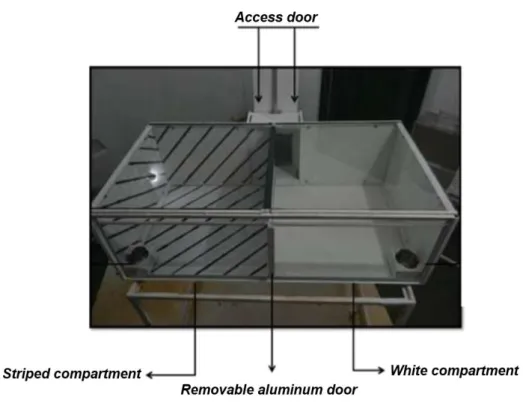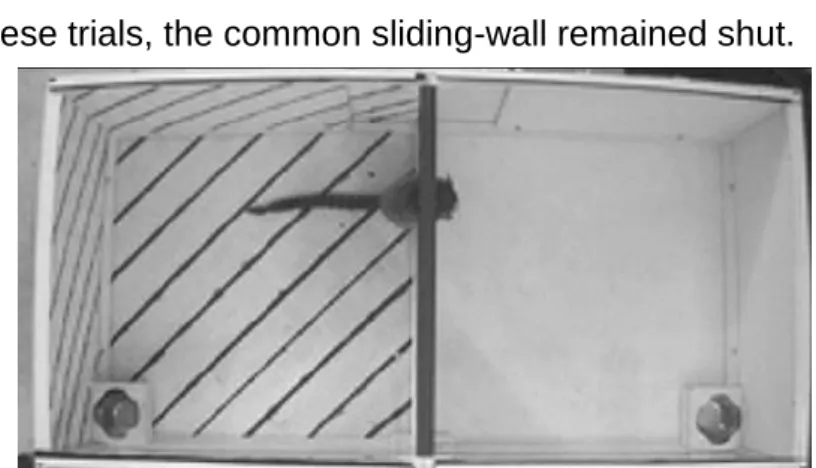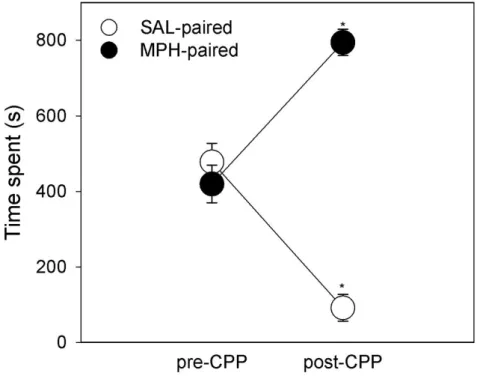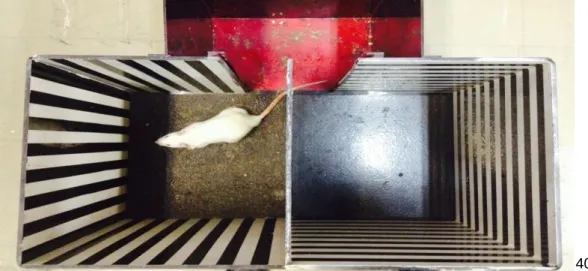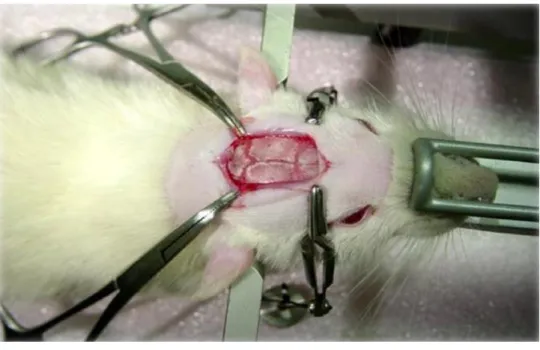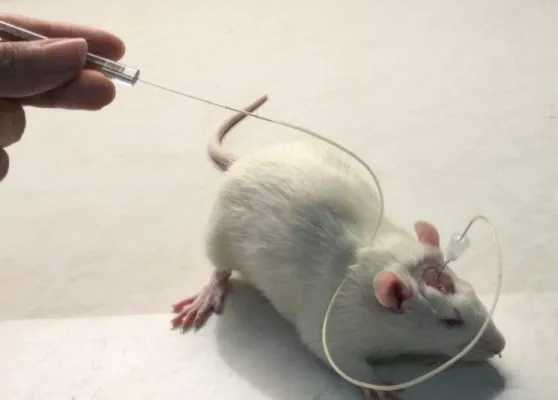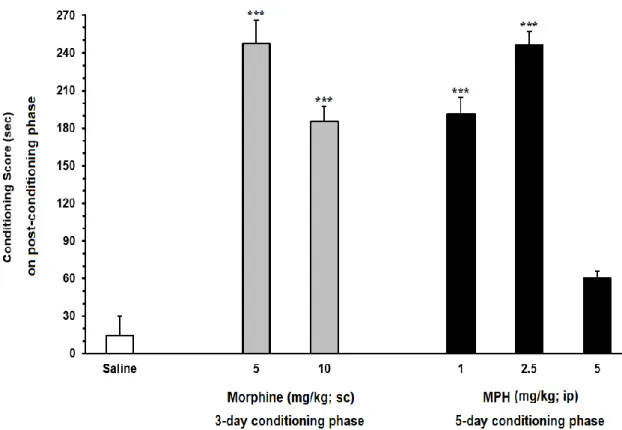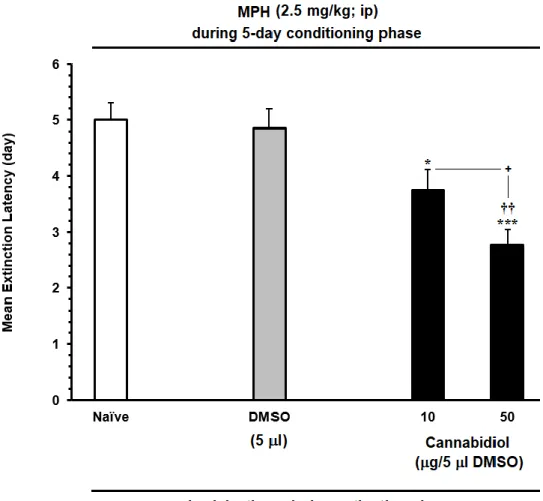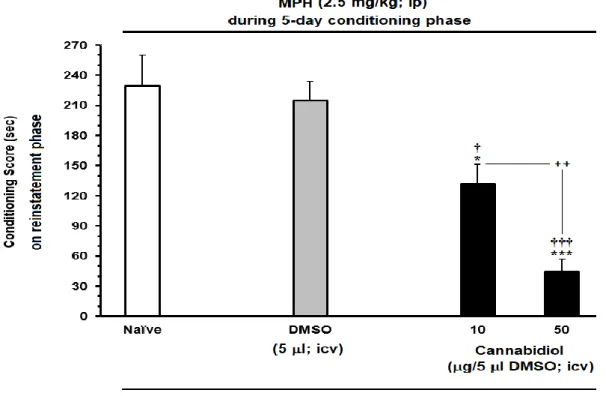i
Universidade de Brasília Instituto de Ciências Biológicas
Programa de Pós-Graduação em Biologia Animal Área: Neurociências e Comportamento
EFFECTS OF CANNABIDIOL ON MORPHINE AND
METHYLPHENIDATE-INDUCED CONDITIONED PLACE PREFERENCE DURING EXTINCTION/ REINSTATEMENT IN MONKEYS AND RATS
Adel Kashefi
Data da defesa 30 January 2020
ii
Adel Kashefi
EFFECTS OF CANNABIDIOL ON MORPHINE AND
METHYLPHENIDATE-INDUCED CONDITIONED PLACE PREFERENCE DURING EXTINCTION/ REINSTATEMENT IN MONKEYS AND RATS
Thesis presented as part of the requirements for obtaining a PhD degree in Animal Biology (area: Neuroscience and Behavior) by the Post-Graduate Program in Animal Biology of the University of Brasília.
Advisor: Prof. Dr. Carlos Alberto Bezerra Tomaz Co-Advisors:Prof. Dr. Abbas Haghparast
Data da defesa 30 January 2020
iii Universidade de Brasília
Instituto de Ciências Biológicas
Programa de Pós Graduação em Biologia Animal A Tese:
EFFECTS OF CANNABIDIOL ON MORPHINE AND METHYLPHENIDATE-INDUCED CONDITIONED PLACE PREFERENCE DURING EXTINCTION/ REINSTATEMENT IN MONKEYS AND RATS
Elaborada por: Adel Kashefi
E aprovada por todos os membros da Banca Examinadora foi aceita pelo Programa de Pós Graduação em Biologia Animal e homologada pelos membros da banca, como requisito à obtenção do título:
Doutor em Biologia Animal BANCA EXAMINADORA
_________________________________________
Prof. Dr. Carlos Alberto Bezerra Tomaz (Presidente)Universidade de Brasília
_________________________________________
Profª Drª Eliza Maria da Costa Brito LacerdaUniversidade Ceuma
_________________________________________
Prof. Dr. Jaquim Pereira Brasil NetoUniversidade Unieuro
_________________________________________
Prof. Dr. João Paulo Figueiró Longoiv
_________________________________________
Prof. Dr. Rafael Plakoudi Souto Maior (Suplente) Universidade de Brasíl
ACKNOWLEDGMENTS
I would like to thank Prof. Dr. Carlos Tomaz and Prof. Dr. Abbas Haghparast for their supervision and guidance over the past four years of my PhD degree in Neuroscience.
I would like to express my special appreciation and thanks to Prof. Dr. Maria Clotilde H. Tavares for her guidance and support to complete my PhD program.
Thank you to my colleagues, Dr. Ana Garcia, Dr. Renata Duarte, Isa and Fernando Magela for academic and social contributions and Shole Jamali and Mehrnoush Rahmani for the great cooperation.
I would like to thank Prof. Ali Rashidy-Pour, Head of Research Center of Physiology, and Prof. Abbas Ali Vafaei, faculty member of Semnan University of Medical Sciences, Semnan, Iran.
Thank you to Department of Physiological Sciences, Institute of Biology, University of Brasilia for the administrative support to achieve the objectives of my doctorate.
Thank you to Department of Physiological Sciences, Neuroscience Research Center, School of Medicine, Shahid Beheshti University of Medical Sciences for the administrative support to achieve the objectives of my doctorate.
Thank you to Profs. Joaquim Brasil Neto and Fábio Caixeta for the excellent suggestions during my qualification exam and contributions to the improvement of my research project.
Many thanks to my friends Edward, Lia, Valeska and Marcos for their support during my stay in Brazil.
v You make my heart melt, and fill it with love... .
“With a wife like you, I feel so blessed... .
“I will love you more and more each day with every beat of my heart, until the day I die and my heart stops beating.
Thank you so much to my dear Mom & Dad, for giving me all the best things they could give. Thank you so much for supporting and understanding me all this period.
vi
The only way to do great work is to love what you do!!!
vii
RESUMO
Justificativa e objetivos: O metilfenidato (MPH) é um estimulante leve do
SNC que tem sido usado em crianças hiperativas, pacientes com neurodegenerativa e principais transtornos depressivos. Exposição a pistas associadas ao MPH aumenta o desejo e a excitação fisiológica em usuários de drogas. Por outro lado, o canabidiol (CBD) é um importante composto não psicoativo e os pesquisadores sugeriram que ele pode ser útil no tratamento da dependência de drogas. O objetivo do nosso estudo foi avaliar os efeitos da administração de CBD no MPH durante a extinção e restabelecimento de preferência-por-lugar condicionado (CPP) em macacos e ratos.
Métodos: Noventa e quatro ratos Wistar adultos machos pesando 200–250 g e
cinco machos adultos de sagui-de-tufos-pretos (Callithrix penicillata) pesando 352 ± 5 g foram utilizados neste projeto de pesquisa. No estudo 1 usando macacos como sujeitos, para indução de CPP, a injeção IP de MPH (5 mg / kg) foi usada diariamente durante uma fase de condicionamento de cinco dias. Sob condições de extinção, os saguis recebiam injeção diária de IP do veículo ou do CBD. A primeira sessão de teste de reintegração ocorreu 24 horas após a última sessão de extinção e os animais receberam uma dose inicial de MPH (1mg / kg) e foram submetidos a um julgamento de reteste de 15 minutos. No Estudo 2, ratos machos adultos receberam MPH (1, 2,5 ou 5 mg / kg, I.P.) ou morfina (5 ou 10 mg / kg, s.c.) durante a fase de condicionamento da CPP. Após o estabelecimento da CPP, durante a fase de extinção, 60 minutos antes da sessão da CPP, os animais receberam diariamente CBD de ICV (10, 50 µg / 5 µl), veículo sozinho (DMSO) ou eram ingênuos. No dia do restabelecimento,
viii os animais receberam a dose inicial de MPH, 0,5 mg / kg, e foram colocados na caixa de CPP para avaliar o escore de CPP durante 10 minutos.
Resultados: Nossos achados indicaram que 5 e 10 mg / kg de morfina ou 1 e
2,5 mg / kg de MPH em ratos e 5 mg / kg de MPH em sagüis induziram CPP. Além disso, a administração de CBD não pôde inibir o restabelecimento da resposta de CPP induzida por MPH em macacos saguis. No entanto, em ratos, a administração ICV de ambas as doses de CBD (10 e 50 µg / 5 µl) suprimiu a reintegração de MPH e exibiu significativamente latências de extinção mais curtas nos grupos tratados em comparação aos grupos ingênuos e / ou DMSO.
Conclusão: Nossos resultados indicam que as injeções de morfina e MPH
induzem o condicionamento da CPP. O CBD evita efetivamente a reposição do MPH em ratos, mas não em saguis. É possível que o CBD possa ser considerado como um tratamento que reduz o risco de recaída; no entanto, isso requer mais investigação.
Palavras-chave: Metilfenidato, Morfina, Canabidiol, preferência-por-lugar
ix
ABSTRACT
Background and aims: Methylphenidate (MPH) is a mild CNS stimulant that has been used in hyperactive children, patients with neurodegenerative and major depressive disorders. Exposure to MPH-associated cues enhance craving and physiological arousal in drug users. On the other hand, cannabidiol (CBD) is a major non-psychoactive compound and researchers have suggested that it might be useful in the treatment of drug addiction. The aim of our study was to evaluate the effects of administration of CBD on MPH during extinction and reinstatement of the conditioned preference place (CPP) in monkeys and rats.
Methods: Ninety four male adult Wistar rats weighing 200–250 g and five male
adult black-tufted-ear marmosets (Callithrix penicillata) weighing 352±5 g were used in this research project. In Study 1 using monkeys as subjects, for induction of CPP, IP injection of MPH (5 mg/kg) was used daily during a five-day conditioning phase. Under extinction conditions, marmosets were given daily IP injection of either vehicle or CBD. The first reinstatement test session occurred 24 h after the last extinction session and animals received a priming dose of MPH (1mg/kg) and were submitted to a 15 min retest trial. In Study 2, Adult male rats received MPH (1, 2.5 or 5 mg/kg, I.P.) or morphine (5 or 10 mg/kg, s.c.) during the CPP conditioning phase. Following the establishment of CPP, during the extinction phase, 60 min before CPP session, animals were given daily ICV CBD (10, 50 µg/5µl), vehicle alone (DMSO) or were naïve. On the reinstatement day animals received the priming dose of MPH, 0.5 mg/kg, and were placed into the CPP box to evaluate the CPP score during 10-min.
x
Results: Our findings indicated that 5 and 10 mg/kg of morphine or 1 and 2.5
mg/kg of MPH in rats and 5 mg/kg of MPH in marmosets induced CPP. In addition, CBD administration could not inhibit the reinstatement of the MPH-induced CPP response in marmoset monkeys. However, in rats, the ICV administration of both doses of CBD (10 and 50 µg/5µl) suppressed the reinstatement of MPH and significantly displayed shorter extinction latencies in treated groups compared to both naïve and/or DMSO groups.
Conclusion: Our results indicate that Morphine and MPH injections induce
CPP conditioning. CBD effectively prevents reinstatement of MPH in rats but not in marmosets monkeys. It is possible that CBD can be considered as a treatment that reduces the risk of relapse; however, this requires more investigation.
Key words: Methylphenidate, Morphine, Cannabidiol, Conditioned Place
xi
LIST OF FIGURES
Figure 1. Illustrative scheme of reward circuit and positive reinforcing effects of drug addiction.. ………..… ... …………..7 Figure 2. Callithrix penicillata (mico-star) kept in the Primatology Center of the University of Brasilia (Photo: Aline Borges)………..… …………..20 Figure 3 . CPP procedure with two different compartments separated by a aluminum wall for evaluating the reinforcing stimuli effects of DEP stimuli, including rewarding (Photo: Aline Borges)... 27 Figure 4. Schematic representation including the two initial habituation trials (H1 and H2) in which marmosets had free access to the entire CPP box, and then followed by the methylphenidate (MPH, 5 mg/kg; I.P; M1–M5) and saline-conditioning trials (S1–S5) ... 28 Figure 5. Top view of the CPP with free access to the two side compartments, made possible by opening of the retractable door (Photo: Aline Borges). .. Error!
Bookmark not defined.8
No table of figures entries found.Figure 7. Time marmosets (n=5) spent
(mean±SEM; in seconds) in the methylphenidate (MPH) paired compartment and the saline (SAL) paired compartment of the CPP box before (pre-CPP; last habituation trial) and after (post-CPP; test trial) the conditioning trials. ... 32 Figure 8. Time marmosets (n=5) spent (mean ± SEM; in seconds) in the methylphenidate (MPH) paired compartment of the CPP box before (pre-CPP; last habituation trial) and after (post-CPP; test trial) the conditioning, on the first, fourth and fifth extinction trial. ... 33
xii Figure 9. Schematic diagram A, to show different doses of morphine (5, 10 mg/kg, s.c.) and B, MPH (1, 2.5 and 5 mg/kg, I.P.) on the conditioned place preference (CPP) during 3 and 5 days respectively. C, Determine the priming doses of MPH in the reinstatement of MPH‐induced CPP, the animals received MPH (0.25 or 0.5 mg/kg; I.P.) on the reinstatement day and then placed into CPP box. D, to investigate the effect of CBD on extinction phase of MPH-induced CPP, after exposed to the effective dose of MPH (2.5 mg/kg, I.P.) the animals were naive or received CBD (10, 50 μg/5μl) or vehicle (DMSO 10%) 60 min before to the extinction sessions. E, to find out whether CBD can inhibit reinstatement of MPH‐induced CPP in rats, animals received CBD or vehicle 60 min before the start of the reinstatement session and then injected by MPH (0.5 mg/kg; I.P.). ... 39 Figure 10. CPP procedure for evaluating the reinforcing effects of natural and pharmacological stimuli, including rewarding, (Photo: Reza Arezoomandan,IRAN). ... 40../Adel PhD File (2).doc - _Toc29194382 Figure 11. Stereotaxic method in rat (Photo: Adel Kashefi, Iran)... 44 Figure 12. Intracerebroventricular (ICV) injection (Photo: Fatemeh Sadeghzadeh, Iran). ... 45 Figure 13. Coronal photomicrograph of representative cannula placement and unilateral microinjection site (CBD or vehicle [DMSO]) in the lateral ventricle of the rat brain (Photo: Adel Kashefi, Iran). ... 45 Figure 14. The effects of different doses of morphine and MPH in the CPP paradigm. Morphine induced CPP in 5 and 10 mg/kg and MPH 1 and 2.5 mg/kg doses. Intraperitoneally (IP) administration of 5 mg/kg MPH during conditioning season couldn't induce preference ... 47
xiii Figure 15. The effects of microinjection of different doses of CBD (C) 10 μg/5 μl and (D) 50 μg/5 μl on the extinction phase (days) of MPH-induced conditioned place preference compared to (A) Naïve or (B) DMSO in rats. Each column represents the mean ± SEM of 5–8 rats. ... 49 Figure 16. The effects of MPH-administration (0.25 or 0.5 mg/kg; I.P.), as priming dose, on the reinstatement of extinguished MPH-CPP in the rats. The established drug-induced CPP, during the extinction, without any injection (A) MPH 1mg/kg and induced reinstatement by priming dose 0.25 mg/kg (B) MPH 2.5 mg/kg and induced reinstatement by priming dose 0.5 mg/kg. Each column represents the mean ± SEM of 5–8 rats. ... 50 Figure 17. Effects of ICV daily injection of CBD (10 and 50 μg/5 μl) during extinction phase on the extinction latency of MPH-induced conditioned place preference compared to Naïve and/or DMSO in rats. Each bar is represented by the mean ± SEM for 5–8 rats. ... 52 Figure 18. Effect of ICV administration of CBD (10 and 50 μg/5 μl, icv) on the preventing the reinstatement induced by priming dose of MPH (0.5mg/kg; I.P.), compared to Naïve and/or DMSO control group. Animals received CBD or vehicle during on reinstatement day before injecting the priming dose of MPH (0.5 mg/kg, I.P.). Each bar is represented by the mean ± SEM for 5–8 rats. .... 54
xiv ADHD – Attention Deficit Hyperactivity Disorder.
AMPH – Amphetamine.
BNST – Bed Nucleus of the Stria terminalis. CBD – Cannabidiol.
CC – Conditioned Compartment. CPP - Conditioned Place Preference. DMSO – Dimethyl Sulfoxide.
DA - Dopamine.
DAT – Dopamine Transporter.
DLPFC – Dorsolateral Prefrontal Cortex. GLU – Glutamate. ICV - Intracerebroventricular. IP - Intraperitoneally. IV- Intravenous. METH - Methamphetamine. MPH – Methylphenidate. NHP – Nonhuman Primates. NE – Norepinephrine (NE). NAc – Nucleus Accumbens. OFC – Orbitofrontal Cortex. 5-HT – Serotonin.
SPECT – Single Photon Emission Computed Tomography. VTA - Ventral Tegmental Area.
xv
CONTENTS
1. INTRODUCTION ... 1
1.1. Brief overview of the status of drug abuse in Iran and Brazil ... 1
1.2. Methylphenidate ... 2
1.2.1. MPH Addiction ... 3
1.2.2. Mechanism of MPH ... 5
1.2.3. MPH Effect on DAT ... 6
1.2.4. Effect of MPH on Reward ... 6
1.3. The Dopamine System ... 8
1.3.1. Dopamine dysregulation and ADHD ... 9
1.4. Other neurotransmitters ... 10
1.5. Reward, extinction and reinstatement ... 11
1.5.1. Brain areas involved in reinstatement of drug and reward seeking. ...12
1.6. Cannabidiol activity ... 15
1.6.1. Mechanisms of CBD in the Brain ... 17
1.7. Callithrix penicillata monkey as an experimental model ... 18
2. JUSTIFICATION ... 21
3. OBJECTIVES ... 22
3.1. General objective ... 22
3.2. Specific objectives ... 22
xvi
4.1. Ethical aspects ... 23
4.2. Animal Subjects and general housing conditions ... 23
4.3. Experimental procedure ... 24
4.4. Drugs ... 25
4.4.1. Preparation of MPH and morphine ... 25
4.4.2. Preparation of Cannabidiol ... 25
5. STUDY 1: EFFECTS OF CANNABIDIOL ON THE EXTINCTION AND REINSTATEMENT INDUCED MPH-INDUCED CPP IN MARMOSETS ... 26
5.1. Experimental subjects ... 26
5.2. Behavioral section ... 26
5.2.1. Conditioning place preference apparatus ... 26
5.3. Experimental procedure ... 27
5.3.1. Pre-conditioning phase: ... 28
5.3.2. Conditioning phase: ... 29
5.3.3. Post conditioning phase: ... 29
5.4. Extinction ... 29
5.5. Reinstatement ... 30
5.6. CPP score and animal movement ... 30
5.7. Behavior analysis ... 30
5.8. Statistical analysis ... 31
5.9. Results ... 31
xvii 6. STUDY 2: DOSE-RESPONSE EFFECTS OF MORPHINE AND MPH AND THE EFFECT OF CBD ON MPH-INDUCED CONDITIONED PLACE
PREFERENCE, DURING EXTINCTION/ REINSTATEMENT ... 36
6.1. Experimental subjects ... 36
6.2. Experimental groups ... 36
6.2.1. Study 1: Dose-response effects of morphine and MPH on the CPP... ... 36
6.2.2. Study 2: Dose response of MPH on the reinstatement of MPH .... 37
6.2.3. Study 3: Effect of ICV administration of cannabidiol on the MPH-extinction in CPP ... 37
6.2.4. Study 4: The effect of ICV administration of cannabidiol on the reinstatement of MPH ... 37
6.3. Behavioral section ... 40
6.3.1. Conditioning place preference apparatus for rats ... 40
6.4. Experimental procedure ... 41
6.4.1. Pre-conditioning phase: ... 41
6.4.2. Conditioning phase: ... 41
6.4.3. Post conditioning phase: ... 42
6.5. Extinction ... 42
6.6. Reinstatement ... 43
6.7. Locomotion tracking apparatus ... 43
xviii
6.9. Surgery and microinjection procedures ... 44
6.9.1. Histology ... 45
6.10. Statistical analysis ... 46
6.11. Result ... 46
6.11.1. The effect of different doses of morphine and MPH on conditioned place preference ... 46
6.11.2. The effect of priming dose of MPH on the reinstatement of MPH . 47 6.11.3. The effect of ICV administration of CBD during the extinction phase, on the extinction latency of MPH-induced CPP ... 51
6.11.4. The effect of ICV administration of CBD on the reinstatement of MPH-induced CPP ... 53
6.12. Discussion ... 54
7. FUTURE PERSPECTIVES ... 61
8. REFERENCES ... 62
9. ANNEX 1 - The approval certificate of Animal Ethics Committee (BRAZIL) .. ... 90
10. ANNEX 2 - The approval certificate of Animal Ethics Committee (IRAN) ... .. 91
1
1. INTRODUCTION
1.1. Brief overview of the status of drug abuse in Iran and Brazil
Drug abuse has been raised as a national problem in Iran and Brazil for a long time (Miraglia, 2015; Amin-Esmaeili et al., 2017). Iran has a lengthy history of opiates being the most common drug of abuse (Assari et al., 2014). In the early 2000s, methamphetamine (METH) entered Iran’s market. Nowadays, METH use is becoming one of the most serious social problem in Iran (Ekici and Ozbay, 2013). It has led to significant health problems, affected the use of methadone for addiction treatment, and has also become a serious menace to HIV/AIDS prevention programs among drug users nationwide (Shariatirad, Maarefvand and Ekhtiari, 2013). Brazil has recently become a main destination country for cocaine and crack. Indeed, the use of cocaine and crack has skyrocketed in the past decade among young people (Abdalla et al., 2014). Although cocaine use in North America decreased significantly between 2006 and 2012, the annual prevalence of cocaine use among Brazil’s college students has remained at 3 percent (Miraglia, 2015). The estimated prevalence of cocaine use among the general population is estimated at 1.75 percent; this is also consistent with the increasing trend of cocaine consumption in Brazil. The use of cocaine has more than doubled since 2005— when about 0.7 percent of the population had used cocaine— and is four times higher than the average worldwide (0.37 percent) (Federal, 2011; Miraglia, 2015). The growth of Brazil's urban population and increases in affluence and disposable income appear to be the principal causes of
2 expanding substance use (Miraglia, 2015).
1.2. Methylphenidate
Methylphenidate (MPH) is an amphetamine-like central nervous system stimulant that has been used in the clinical treatment of major depression, neurodegenerative disorders, cognitive improvement in patients with brain tumors, AIDS disease, fatigue and as a treatment for delirium and sedation related with opioid use (Prommer, 2012). On the other hand, this medicine is most frequently prescribed for the management of Attention Deficit and Hyperactivity Disorder (ADHD) in children and teenagers (Goldman et al., 1998; Pliszka, 2007). Actually, MPH is the first option of prescribed treatment for children and adolescents who have been diagnosed with ADHD (Klein-Schwartz and McGRATH, 2003; DuPont et al., 2008; Prommer, 2012). Moreover, within the population of children, ADHD is one of the most common neurodevelopmental disorders of childhood, with approximately 3% to 10% of school aged children in the United States (Buitelaar, 2002). Worldwide, it is estimates about 5% for children and adolescents diagnosed with ADHD (Polanczyk et al., 2007). Diagnosis is dependent on parent and teacher accounts as there is no existing laboratory test able to verify diagnosis (Rowland, Lesesne and Abramowitz, 2002). Thus, the incidence of ADHD can be a complex process because of the subjective nature of parent and teachers account of a child’s behavior. Furthermore, this disorder has a high rate of comorbid diagnosis such as learning disability, behavior disorder and anxiety disorder (Rowland, Lesesne and Abramowitz, 2002). The behavioral symptoms of these disorders often simulate the similar behavioral symptoms of ADHD that can
3 cause symptoms and behaviors that may be mistaken for ADHD. New diagnosed cases of ADHD have been increasing considerably and concomitantly the prescription of stimulants for treatment (Safer, Zito and Fine, 1996; Greenhill, Findling and Swanson, 2002; Cox et al., 2003; Olfson et al., 2003; Rowe, Robinson and Gordon, 2005). It is important to note that a significant population of children who are diagnosed may not have ADHD (Mayes, Bagwell and Erkulwater, 2008). However, prescription rates of MPH tripled during the early 1990s (Safer, Zito and Fine, 1996; Zito et al., 2000). The rise in prescription rates of MPH appeared to coincide with news that varying dose amounts of MPH elicited tolerance, sensitization, and withdrawal (Yang, Swann and Dafny, 2006), suggesting that MPH can elicit dependence and display a potential for abuse.
1.2.1. MPH Addiction
The potential for abuse and dependence of MPH is alarming considering the rise in the amount of children misdiagnosed and then prescribed a stimulant medication for treatment (Klein-Schwartz and McGRATH, 2003; DuPont et al., 2008; Prommer, 2012). Evidence suggests that MPH abuse has substantially increased over the past several years (Looby and Earleywine, 2011; Brookshire and Jones, 2012). In the USA, of those persons age 12 and older, 4.2 million have used MPH recreationally at least once in their life (Substance Abuse and Mental Health Services Administration, NSDUH, 2005). Additionally, in 2005 there were 3,212 MPH drug-related hospital emergencies and by 2010 that number had risen to 4,089 (Substance Abuse and Mental Health Services Administration, DAWN, 2010). There are some factors that may contribute to the illegal use
4 of MPH, and route of administration is one that appears to play an important role (DuPont et al., 2008; Volkow and Swanson, 2008). Oral administration is the most common method of administration (McGough et al., 2006). For instance, (DuPont et al., 2008) confirmed that 86% of those college students who used MPH recreationally did so by oral and intranasal routes of administration. Previous studies have reported higher incidences of MPH abuse through inhalation, with 75% of abusers self-administering MPH through this route (Morton and Stockton, 2000; Bright, 2008). Additionally, studies have also suggested that oral administration of MPH may result in reinforcing effects and this effect appears to be dose-dependent (Jasinski, 2000; Rush and Baker, 2001), while other studies using self-report data have suggested that recreational use is very common (Teter et al., 2006; DuPont et al., 2008). Lastly, past studies have verified that the use of extended-release MPH formulations have helped to eliminate the abuse liability (Kollins et al., 1998; Berridge et al., 2006; Parasrampuria et al., 2007). However, given the route of administration (oral and intranasal) of typical recreational abuse, extended-release formulations of MPH may not negate the abuse responsibility of MPH. The most popular route of administration for recreational use of MPH is through intranasal administration (Bright, 2008) after several pills have been crushed. Intranasal administration avoids the first-pass metabolism in liver and is quickly absorbed into the bloodstream through the soft tissues in the mucous membrane. This allows for faster onset of bioavailability of the drug. Hence, MPH administered via this route negates differences in formulations, and rapid onset of the effects of the drug has been reached. If the drug is
5 taken through other routes of administration, it can reach the brain more rapidly and produce more important effects on the reward system (Volkow and Swanson, 2003; DuPont et al., 2008). Studies have shown that MPH bioavailability in the brain is increased in rats using the intraperitoneal (ip) route (Berridge et al., 2006).
1.2.2. Mechanism of MPH
The primary mechanism of MPH is to bind and block the dopamine transporter (DAT) and to a lesser extent, the norepinephrine (NE) transporter (Schweri et al., 1985; Solanto, 1998). The blockade of both the DAT and NE transporter diminishes synaptic clearance of these neurotransmitters, leaving behind high levels of monoamines in the synaptic cleft. This mechanism is similar that of cocaine and should be a matter of concern considering cocaine is a drug of abuse that has been shown to have reinforcing effects and is commonly abused (Swanson and Volkow, 2003). In fact, cocaine is considered one of the most commonly abused drugs, and like amphetamine (AMPH) as well as MPH, causes increases of extracellular dopamine in the brain (Volkow and Swanson, 2003). Studies have shown that MPH produces an increase of dopamine within the nucleus accumbens, which is believed to underlie the rewarding effects of drugs of abuse (Di Chiara and Imperato, 1988). MPH-induced increases of dopamine presumably underlie the reinforcing aspects of this drug, although its rewarding effects are dose-dependent (Nora D Volkow et al., 1999).
6
1.2.3. MPH Effect on DAT
DAT is the main mechanism responsible for regulating of extracellular dopamine and blockade of the DAT is the neurobiological mechanism for MPH effect. DAT mediates the majority of DA uptake into neurons that is the primary mechanism through which DA is cleared from the synapse. MPH has been shown to produce a considerable decrease of DAT protein in younger animals (Moll et al., 2001) and in adults (Izenwasser et al., 1999) and reverse the enhancement in striatal DAT in an animal model of ADHD (Roessner et al., 2010). Further, in adult male rats, in vivo quantification of the DAT using small animal Single Photon Emission Computed Tomography (SPECT) discovered a dose-dependent decrease of striatal DAT after Intravenous (IV) administration of MPH (3 and 10 mg/kg) 2 h post drug treatment, but nucleus accumbens was not analyzed (Nikolaus et al., 2010). Finally, one study which analyzed 0.75 and 1.5 mg/kg MPH given for 7 days reported no changes in the DAT of several brain areas, including the nucleus accumbens shell and core (Bello and Hajnal, 2006). Hence, it appears that individuals with elevated DAT levels, such as ADHD sufferers, may be more susceptible to the addictive effects of amphetamine-like drugs.
1.2.4. Effect of MPH on Reward
Previous studies have established that MPH is able to induce conditioned place preference in rodents (Martin-Iverson, Ortmann and Fibiger, 1985; Mithani et al., 1986). Most relevant to our work, (Meririnne, Kankaanpää and Seppälä, 2001) reported that doses of MPH ranging from 1.25 to 20 mg/kg produced conditioned place preference (CPP). Interestingly, a dose of 0.62 mg/kg showed only a trend to preference, and a dose of 0.31 mg/kg did not
7 Figure 1. Illustrative scheme of reward circuit and positive reinforcing effects of drug addiction. The neurons of the VTA contain dopamine which is released into the nucleus accumbens and prefrontal cortex in response to artificial reward stimuli. stimulation of the reward pathway produces highly pleasurable sensations, providing positive reinforcement whith promotes futher drug use. (Figure taken from the :https://www.slideshare.net/dawnvtomy/physiology-of-drug-addiction).
produce any preference. These two lower doses, when given IP, produce brain concentrations that are similar to therapeutic doses of MPH (Berridge et al., 2006; Devilbiss and Berridge, 2006). It has also been verified that rats will self-administer MPH dose dependently on a fixed ratio (FR1) and progressive ratio (PR) schedules (Botly et al., 2008). Interestingly, the effects of the dopamine D1 receptor antagonist SCH 23390 and dopamine D2 receptor antagonist eticlopride at a dose of 0.01 and 0.03 mg/kg increased the number of MPH infusions on FR1 schedule and decreased breaking points on PR schedule. These above results demonstrate the rewarding aspects of MPH and other psychostimulants regulated by both D1 and D2 receptors and contribute to reinforcement behavior (Figure 1).
8
1.3. The Dopamine System
The mesolimbic dopaminergic system is organized by dopaminergic cell bodies within the ventral tegmental area (VTA). The VTA sends a major axonal projection to both the nucleus accumbens and prefrontal cortex, and this system forms the brain’s reward system. These brain areas also send reciprocal projections back to the VTA. This pathway is also identified as the medial forebrain bundle. Dopamine (DA) has been shown to be essential in the rewarding properties of psychostimulants (George, Le Moal and Koob, 2012). All addictive substances have been shown to activate the mesolimbic DA pathway, including cocaine, AMPH, and METH. Research has shown that all drugs of abuse enhance DA release within this pathway of the brain’s reward system (Volkow et al., 2009). Dopamine binds to two families of receptors: the D1 and D2. The D1 receptor has two receptor subtypes: the D1 and D5. The D2 receptor family has three receptor subtypes: the D2, D3, and D4. Both of these receptor families are metabotropic G-protein coupled dopamine receptors that negotiate the physiological functions of DA. Behaviorally, DA plays a main role in voluntary movement, reward, hormonal regulation as well as hypertension (Beaulieu and Gainetdinov, 2011). Therefore, many other drugs that target dopaminergic neurotransmission have been clinically prescribed for the management of several neurodegenerative and behavioral disorders includingParkinson’s disease, schizophrenia, bipolar disorder, Huntington’s disease, Tourette’s syndrome as well as ADHD. Previous studies have demonstrated that dopamine D1 receptors are involved in the development of sensitization to the rewarding properties of psychostimulants (Meririnne, Kankaanpää and Seppälä, 2001).
9 For example, it has been shown that the D1 antagonist SCH 23390 prevents self-administration of AMPH prior to treatment (Pierre and Vezina, 1998) and also cocaine induced conditioned place preference (Shippenberg, Heidbreder and Lefevour, 1996). In contrast to D1-antagonism, the D2-antagonist raclopride (RAC) was ineffective in blocking conditioned place preference to cocaine. On the other hand, it should be noted that D2-antagonists have prevented development of sensitization to locomotor-stimulating effects of AMPH and METH (KURIBARA and UCHIHASHI, 1993; Meng, Feldpaush and Merchant, 1998) Accordingly, there is reasonable evidence to suggest that D2 receptors may be involved in the rewarding properties of particular psychostimulants.
1.3.1. Dopamine dysregulation and ADHD
Research has confirmed that DA dysregulation is involved in those individuals diagnosed with ADHD (Volkow and Swanson, 2008). DA is implicated in the brain as a mediator of reinforcement signals (Carmona et al., 2009) and if ADHD consists of alterations in reward processing, then altered dopamine functioning can cause symptoms of ADHD (Tripp and Wickens, 2009). Tripp and Wickens (2009) have proposed a theory (dopamine transfer deficit) that suggests some symptoms of ADHD are a direct result of the breakdown of the transfer of the DA cell response to a cue that predicts reinforcement. Critically, prior imaging work has shown that children diagnosed with ADHD demonstrate a lower DA response in the ventral striatum to stimuli that involved anticipation of reward (Luman, Tripp and Scheres, 2010). Thus, it is hypothesized that there is a decreased phasic DA neuronal response in those diagnosed with ADHD and MPH
10 works to normalize this lack of response (Tripp and Wickens, 2008). Therefore, it makes sense that the pharmacological properties of psychostimulants clinically prescribed to treat these disorders act on the mesolimbic DA pathway. However, a variety of addictive substances such as cocaine, AMPH, act directly on this pathway as well. Therefore, delayed reinforcement at the cellular level occurs by a decline in phasic DA cell response to a cue that predicts reinforcement, hence rendering it ineffective. This would only happen after the positive reinforcer is delivered and would explain the unusual response to delay of reinforcement in children with ADHD (Tripp and Wickens, 2009). Children who do not have ADHD experience no delay in anticipatory dopamine signaling.
1.4. Other neurotransmitters
Previous studies indicate MPH has a high binding affinity for NE transporters (Gatley et al., 1996; Kuczenski and Segal, 1997). Kuczenski and Segal (1997) demonstrated that hippocampal levels of NE were elevated following MPH administration. Using glucose metabolism as a measure of MPH's activity within different brain regions, Volkow and colleagues (1998a) found that glucose metabolism in the cerebellum was enhanced following MPH treatment. Typically, MPH's effect on glucose metabolism is attributed to activation of D2-R's. Although, the cerebellum does not contain D2-R's it is postulated that the cerebellar increases in glucose metabolism are due to activity on NE (Volkow et al., 1997; Leonard et al., 2004). MPH has been shown to indirectly increase levels of ACh in the prefrontal cortex via stimulation of the D 1 -R's (Acquas and Fibiger, 1996; Leonard et al., 2004). Generally, ACh levels are increased by Dl-like
11 receptor activation, whereas D2-R activation reduces ACh release (Berlanga, Simpson and Alcantara, 2005). Cholinergic interneurons in the striatum express both D5 and D2 receptors. These interneurons are essential in associative learning as well as planning and executing movement. It has also been shown that the D 1-like and D2-like receptors can have a synergistic effect that is linked to synaptic plasticity and learning (Kashihara et al., 1999; Silkis, 2001).
1.5. Reward, extinction and reinstatement
Effects of drug abuse on the brain are much more dramatic than natural rewards, such as food and social interactions. Drug abuse is a chronic and enduring phenomenon, which is major public health concern. Relapse, the resumption of drug abuse following abstinence or extinction, remains the major problem for the treatment of addiction. Relapse occurs in response to different precipitating events, including stress and drug priming dose (Gerber and Stretch, 1975; Perry et al., 2014). One of the main aspects in substance abuse is extinction, a form of learning in which associations between cues and the events they predict are weakened by exposure to the appetitive cues in the absence of those events. Evidence from animal models suggests that conditioned responses to drug cues can be extinguished. Investigations into the neurobiological substrates of extinction of conditioned drug craving and withdrawal may facilitate the successful use of drug cue extinction within clinical contexts and treatment programs (Myers and Carlezon Jr, 2010).
In the place conditioning paradigm, extinction training can occur in either of two ways: animals can be given free access to the place conditioning
12 apparatus in repeated test sessions, or animals can be restricted in the formerly drug- or withdrawal-paired context in the absence of drug administration or precipitated withdrawal (i.e., following an injection of saline) and afterward given free access tests to assess extinction. When extinction has happened, there no longer is a preference for or aversion to the previously drug- or withdrawal-paired context; that is, animals spend approximately equal amounts of time in each of the 2 compartments (Myers and Carlezon Jr, 2010).
Neurophysiologic mechanisms underlie the uncontrolled, compulsive behaviors defining the addicted state. These “hard-wired” alterations in the brain are considered critical for the transition from casual to addictive drug use.
1.5.1. Brain areas involved in reinstatement of drug
and reward seeking
An understanding of the role of the addictive process therefore also requires the inclusion of brain regions neuronally linked to the ventral tegmental area (VTA) and nucleus Accumbens (NAc). VTA supplies dopaminergic innervation not only to the NAc, but also to the amygdala and bed nucleus of the stria terminalis (BNST). In addition, the VTA projects DA from a third dopaminergic tract, the mesocortical pathway, which innervates prefrontal cortical regions that include the orbitofrontal cortex (OFC) and anterior cingulate. Coupled with glutaminergic and other reciprocal neurotransmitter connections, the NAc is integrated with the OFC, anterior cingulate, insular cortex, and hippocampus (Adinoff, 2004).
13
1.5.1.1. Amygdala
Activity of the amygdala has been associated to memory consolidation for emotionally arousing events (Tyng et al., 2017). The amygdala is involved in incentive motivational value of rewards to stimuli and in the conditioning of fear to novel stimuli. For example, animals favoring a specific cage that is identified with drug administration will lose this conditioned stimulus if the amygdala is ablated (Adinoff, 2004).
1.5.1.2. Anterior cingulated
Implicated in human disorders of emotion and attention, the anterior cingulate is involced in emotional self-control, focused problem-solving, error detection, performance monitoring, and adaptive response to changing conditions (Allman et al., 2001). It plays a role in the conflict detection processing, particularly when low-frequency responses are performed (Braver et al., 2001), but is influenced by both motivation and affective state.
1.5.1.3. Bed nucleus of the stria terminalis (BNST)
BNST has been implicated in autonomic, hormonal and behavioral reactions to fearful stimuli, including the stress response (Choi et al., 2007). The BNST is considered part of the extended amygdala and shares with the nucleus accumbens a sensitivity to dopamine stimulation. In rodents, the BNST is involved in the reinstatement of cocaine seeking after foot shock (Erb and Stewart, 1999).
1.5.1.4. Dorsolateral prefrontal cortex (DLPFC)
The DLPFC appears to be specialized for holding/maintaining several pieces of information “on line” or in short-term storage of information (i.e.,
14 “working memory”) (Petrides, 2000). The DLPFC is essential for the control and regulation of cognitive activities, including the sequencing of events, planning, and the selection of goals (Dixon, 2015).
1.5.1.5. Hippocampus
Crucial for fast acquisition of new factual information and the formation of new memories about personally experienced events (i.e., episodic memory), the hippocampus has been involved in the memory loss in Alzheimer’s disease (Maruszak and Thuret, 2014). Damage to the hippocampus causes anterograde amnesia with a lesser degree of retrograde amnesia (Broadbent, Squire and Clark, 2007).
1.5.1.6. Insular Cortex
Insula is part of the cerebral cortex and plays a role in a wide range of functions including processing of visceral and somatosensory inputs, olfaction, craving, addiction and emotions such as pain (Ghaziri et al., 2018). It possibly plays an important role in relating interceptive signals and often in acute anxiety studies (Shin and Liberzon, 2010).
1.5.1.7. Orbitofrontal cortex (OFC)
As a part of prefrontal cortex implicated in disorders of impulsivity and decision making, the OFC is involved in situations that are unpredictable or uncertain, and modulates the reinforcement value of stimuli in the context of recent experience (Tsuchida, Doll and Fellows, 2010). It determines and decodes the likely value or behavioral relevance of available choices of action and is therefore activated when there is lack of information available to determine an appropriate course of action (Adinoff, 2004). It has been
15 suggested that the medial OFC (ventromedial cortex), with connections to the hippocampus and cingulate, is implicated in assessing the familiarity or “rightness” of a situation and in integrating outcome expectancies (Adinoff, 2004). The lateral OFC, with connections to the amygdala and insula, is connected with the suppression of previously rewarded responses and is required to change behavior (i.e., to provide “stop” signals) (Elliott, Dolan and Frith, 2000).
1.6. Cannabidiol activity
The plant Cannabis sativa has been used for many centuries. It is known to have therapeutically relevant properties and has about 400 different identifiable chemical constituents; more than 60 of them are cannabinoids (Schillack, 2018). Cannabinoids exert their effects by interaction with specific endogenous cannabinoid receptors such as cannabinoid receptor type 1 (CB1). This receptor is expressed predominantly in central nervous system, in areas that can mediate most of the effects on cognitive function, pain and short-term memory (hippocampus and cerebral cortex), motor control and coordination (basal ganglia and cerebellum), hypothermia and hyperphagia (hypothalamus), and expression of the CB2 receptor is restricted to immune cells, T-cells, B-cells, spleen, tonsils and activated microglial cells and suggested that play a relevant role in the rewarding, reinforcing, and motivational effects (Herkenham et al., 1991; Tsou et al., 1998).
Cannabidiol (CBD), one of the main constituents from the cannabis plant, was previously proposed as a cannabinoid devoid of psychopharmacological activity (Formukong, Evans and Evans, 1988). CBD is a drug with multiple mechanisms of action (Zuardi and Karniol, 1983), including
anti-16 inflammatory effects (Walter et al., 2003; Costa et al., 2004) antioxidative, a potent inhibitor of cancer cell growth, and neuroprotective effects (Valvassori et al., 2011). In addition, CBD is known by the action on ischaemia, antiepileptic and antipsychotic actions and anxiolytic effects, these effects were observed in animal models, as well as in humans (Fleury-Teixeira et al., 2019). Moreover, it has been suggested also that the endocannabinoid system may be involved in the pathophysiology of depression and that CBD may have agonist properties at 5-HT-1A receptors, which have been related to the therapeutic effect of antidepressant drugs (Shirayama et al., 2002; de Souza Crippa et al., 2004). Also, (Harrison and Markou, 2001) confirmed a modulatory role of 5-HT-1A receptors in brain stimulation reward. However, the mechanisms underlying those effects are not fully understood. One possibility is that activation of 5-HT-1A receptors by CBD could inhibit extracellular concentrations of serotonin and/or attenuates mesolimbic activity. Recently, it reported the CBD attenuates cue-induced reinstatement of heroin seeking (Katsidoni, Anagnostou and Panagis, 2013). A study has shown that the CBD lacks hedonic properties and blocks the reward-facilitating effect of morphine (Parker et al., 2004). Another study showed that the administration of CBD can reverse and/or prevent in rats the behavioral and oxidative stress effects induced by chronic use of D-amphetamine in an animal model of mania. It has been found that CBD may increase activation of 5-HT1A receptors and the subsequent hippocampal expression of brain derived neurotrophic factor (BDNF) (Saarelainen et al., 2003; Duman and Monteggia, 2006).
17
1.6.1. Mechanisms of CBD in the Brain
CBD may also interact with the endocannabinoid system through indirect mechanisms such as improved action of the endogenous cannabinoid ligand anandamide. This results from blockade of anandamide reuptake and the inhibition of its enzymatic degradation (Mechoulam and Hanuš, 2002; Jiang et al., 2011; Bih et al., 2015). CBD has been shown to modulate several non-endocannabinoid signaling systems. It is not clear which, if any, of these mechanisms are responsible for any of CBD’s potential clinical or other effects. Some of these mechanisms include: Inhibition of adenosine uptake, possibly resulting in indirect agonist activity at adenosine receptors, enhanced activity at the 5-HT1a receptor, enhanced activity at glycine receptor subtypes and blockade of the orphan G-protein-coupled receptor GPR55 (Bih et al., 2015).
CBD has also the ability to enhance adenosine signaling through inhibition of its uptake and also has low affinity as a CB1 receptor antagonist (Thomas et al., 2007), leading researchers to search for alternative sites of action to explain its effects. CBD can act as a partial agonist to the 5HT-1A serotonin receptor (Pertwee, 2004; Russo et al., 2005), a weak partial agonist for D2 receptors (Seeman, 2016), a weak negative allosteric modulator to Mu opioid receptors (Kathmann et al., 2006) and activates the GPR55 receptor (Ryberg et al., 2007). Recently, researchers have focused on CBD’s involvement with the 5HT-1A receptor to regulate cell-to-cell communication. In general, activation of the 5HT-1A autoreceptors located on post synaptic somato-dendritic sites causes inhibition of that cell’s firing output (Tada et al., 2004; Polter and Li, 2010). Following this cell firing
18 inhibition, CBD administration could potentially inhibit post-synaptic transmission and therefore affect the activity of projected areas. For instance, intracranial infusion of CBD in the shell of the nucleus accumbens (NASh) can attenuate ventral tegmental area (VTA) dopamine neuron firing (Norris et al., 2016; Renard et al., 2017).
1.7. Callithrix penicillata monkey as an experimental model
Most preclinical studies use rodents as an animal model to investigate the process of dependence (Puhl et al., 2011; Corwin and Babbs, 2012). Undoubtedly, experiments with rodents are of paramount importance and have given numerous contributions to the current understanding of the neural mechanisms that support the process of dependence. However, studies with nonhuman primates have been employed more frequently in neuropharmacological and behavioral approaches (Valentinuzzi et al., 2008; Arce et al., 2010; Chabrawi and Barros, 2011; Melamed et al., 2013). The use of non-human primates favors the generalization of results for humans, since the phylogenetic aspects, the morpho-functional organization and the behavioral and neurochemical aspects are closer to humans (Hacia et al., 1998; Piggott et al., 1999; Weerts, Fantegrossi and Goodwin, 2007).The genetic homology between non-human and human primates is around 95%, depending on the species studied (Hacia et al., 1998). In addition, the brains of nonhuman primates exhibit all subdivisions of the prefrontal cortex seen in the human brain (Carmichael and Price, 1994; Preuss, 1995). Primates, in general, present a great diversity of social systems (Isbell and Young, 2002) and thus are more vulnerable to psychosocial stress, also exhibiting similar responses to humans (Norcross and Newman, 1999; Pryce et al., 2005).
19 On the other hand, using primates as experimental subjects requires a lot of care in order to ensure reliable and reproducible results in biomedical research. In order to avoid behavioral and/or physiological abnormalities, it is necessary to observe the specific needs of the species in terms of diet, housing type, physical space, and opportunities for reproduction and social interactions. Other aspects also need to be considered, such as the stress caused by management procedures, hygiene, consanguinity and periodic health examinations. The use of small New World primates, such as marmosets has several advantages that are reflected in their low captive maintenance cost and good reproduction rate, requiring small maintenance spaces and a lower cost when compared to other species of primates (Orsi et al., 2011).
The individuals of the species Callithrix penicillate (Hershkovitz, 1977): Order: Primates, Family: Callitrichidae, Callithrix-mico-estrela; Figure 2) have been established as experimental subjects in biomedical, behavioral and neuropsychopharmacological investigations of animal studies (see Barros and Tomaz, 2002).They are small primates with large black tufts behind its ears. The head is black or brown mixed with gray and white patch on the forehead and the body is gray/brown, brush-shaped. They exhibit a characteristic white spot on the forehead in star format, deriving its popular name (de Vivo, 1991; Auricchio, 1995). They are diurnal animals and predominate in the Cerrado and Caatinga biomes of Brazil (Rylands, 2000). With regard to their eating habits, they are omnivorous animals, exhibiting a generalist strategy in obtaining resources (Rylands, 1993).They feed on a wide variety of plant matter (exudates/gums, seeds, flowers, fruits, nectar)
20 and animals (arthropods, molluscs, small birds and mammals, amphibians and small reptiles) (Ferrari and Ferrari, 1989; Vilela and Faria, 2002)
Studies in our own research group have demonstrated that repeated cocaine administration in marmoset monkeys induces hypervigilance-related behaviors (Cagni et al., 2012). It is also reported that Neurokinin3 receptor modulation of the behavioral and neurochemical effects of cocaine in Callithrix penicillata (Souza Silva et al., 2008). In this context, several studies have successfully confirmed the use of Callithrix penicillata in studies that investigate the physiological and behavioral responses to drugs of abuse. Therefore, it seems this primate is an unique experimental model for behavioral and psychopharmacology studies and substance use disorder (Barros et al., 2003, 2007; Mello et al., 2005; Silva et al., 2006; Lima et al., 2008; Souza Silva et al., 2008; Melamed et al., 2013).
Figure 2. Callithrix penicillata (mico-star) kept in the Primatology Center of the University of Brasilia (Photo: Aline Borges).
21
2. JUSTIFICATION
Animal research suggests that, as with the psychostimulants, opiates appear to mediate their reinforcing effects by modulating the activity of the mesolimbic pathway, although not directly (Shippenberg and Elmer, 1998). The opiates enhance NAc dopamine release by increasing the activity of VTA dopamine neurons. It is postulated that this is achieved via activation of mu-opioid receptors located on GABA neurons within the VTA, which play an important role in regulating the activity of VTA dopamine neurons. Opiates also have dopamine-independent effects within the NAc, which play an important role in opiate reward (Koob and Bloom, 1988).
In addition, MPH blocks the DAT, the key mechanism responsible for the removal of extracellular dopamine (DA), thereby elevating extracellular DA levels in various limbic, striatal, cortical, cerebellar terminal fields and increasing DA signaling and duration of DA response (Solanto, 1998). Neuroimaging studies showed that therapeutic doses of MPH increased DA levels in the striatum and NAc and suitable manipulation of this system can be effective in MPH-induced reward, extinction and reinstatement. Although CBD has been shown to affect emotional responses, few researchers have evaluated its effects in relation to brain reward and addiction in monkeys (Ren et al., 2009). In fact, no studies have been done about the effects of CBD on the extinction and reinstatement of morphine and MPH-Induced conditioned place preference in animal models. Therefore, in this research project, we investigated the effects of CBD on brain stimulation reward and reward-facilitating effects of morphine and MPH-induced conditioning in both monkeys and rats.
22
3. OBJECTIVES
3.1. General objective
The main objective of this study was to investigate the effects of Cannabidiol (CBD) on MPH-induced conditioned place preference during extinction and reinstatement in the non-human primate species Callithrix penicillate as well as in rats.
3.2. Specific objectives
1) Investigate the effect of daily injection of the CBD on conditioning and extinction of MPH-induced CPP in Callithrix penicillate.
2) Investigate the effect of single injection of the CBD on reinstatement of MPH seeking behavior in MPH-extinguished Callithrix penicillate.
3) Investigate the effect of Morphine injection on conditioning and extinction of CPP task in rats.
4) Invetsigate the effect of Morphine on reinstatement and seeking behavior in rats.
5) Investigate the effect of daily injection of the CBD on extinction of MPH-induced CPP in rats.
6) Investigate the effect of single injection of the CBD on reinstatement of MPH seeking behavior in MPH-extinguished rats.
23
4. MATERIAL AND METHODS
4.1. Ethical aspects
The experiments with monkeys were approved by the Animal Ethics Committee (CEUA) of the Institute of Biological Sciences of the University of Brasília (Annex 1). All the ethical precepts stipulated by COBEA (Brazilian College of Animal Experimentation) have been observed. The study was carried out with animals kept in captivity on the Primate Center / CP-UnB, which is accredited by the Brazilian Institute of Environment and Renewable Natural Resources (IBAMA) as a primates breeding place for scientific purposes (IBAMA Register, 1/53/1999 / 000006-2). The experiments with rats were conducted in Iran and were performed in accordance with the guide for the care and use of laboratory animals (National Institutes of Health Publication No.80-23, revised 1996) and were accepted by the Research and Ethics Committee of Shahid Beheshti University of Medical Sciences (Annex 2).
4.2. Animal Subjects and general housing conditions
In all experimental stages of this study adult (> 18 months) male Callithrix penicillate. Were used pair-housed in different home-cages (2 × 1 × 2 m each) of a same colony room at the Primate Center of the University of Brasilia. This room consisted of a semi-outdoor/indoor housing system with two parallel rows of 12 cages each, separated by a common wire-mesh enclosed central corridor. The animals were thus exposed to natural light, temperature and humidity conditions. Fresh food was provided daily at 07:00 h, consisting of a mixture of pieces of fruits and vegetables, and unconsumed items were removed by 17:00 h. Boiled eggs, nuts and/or
24 cooked chicken breast were given several times a week, also at 07:00 h. Water and chow were available ad libitum. Animals were tested in random order on each day and all sessions held between 08:00 and 13:00 h. Housing conditions complied with the regulations of the Brazilian Institute of Environment and Renewable Natural Resources (IBAMA).
The experiments conducted in Iran were performed on male adult Wistar rats (Pasteur Institute, Tehran, Iran) weighing between 220 g and 250 g on the first conditioning day. Rats were housed in groups of four per cage, with ad libitum access to food and water, in a temperature-controlled room with a 12/12 h light/dark cycle (lights on at 7:00 PM). Each experimental group consisted of 5–7 animals and were used only once for each test. The tests were performed between 9:00 a.m. and 2:00 p.m.
4.3. Experimental procedure
Our research was divided into two parts: The first study consisted of pharmacological and behavioral experiments on Marmosets; In the second study, behavioral experiments with the CPP paradigm was used to investigate the effects of different doses of Morphine or MPH and also examined effects of intravenous administration of CBD on MPH-induced conditioned place preference, during extinction/ reinstatement in rats.
The methodology, results and discussion of these studies will be presented for each study individually.
25
4.4. Drugs
4.4.1. Preparation of MPH and Morphine
Methylphenidate hydrochloride (synthesized by Laboratory of Medicinal Chemistry, Novartis Pharma Services, Tehran, Iran) was freshly diluted in saline and injected intraperitoneally (IP) and morphine sulfate (Temad, Iran) was dissolved in physiological saline (0.9% NaCl) and administered by subcutaneous (s.c.) route at the dose of 5 and 10 mg/kg in conditioning phase in rats.
For marmosets, pills of Methylphenidate hydrochloride (MPH; 5.0mg/kg; Ritalin®, Novartis, Brazil) were macerated and dissolved in phosphate-buffered saline.
4.4.2. Preparation of Cannabidiol
For the experiments with rats CBD (Tocris Bioscience, St. Louis, Missouri, USA), was dissolved in a mixture of dimethyl sulfoxide (DMSO) and 10%and 90% phosphate‐buffered saline solution. Intracerebroventricular (ICV) microinjections were performed using a 5-μL Hamilton syringe into the lateral cerebral ventricle (10 μg/5 μL) of the rat.
For monkeys, Cannabidiol (CBD; STI Pharm, UK) was dissolved in a 1:19 solution of Tween 80 (Sigma-Aldrich, Brazil) and phosphate-buffered saline and the injections were ip.
26
5. STUDY 1: EFFECTS OF CANNABIDIOL ON THE EXTINCTION AND REINSTATEMENT OF MPH-INDUCED CPP IN MARMOSETS
5.1. Experimental subjects
Five male adult black-tufted-ear marmosets (Callithrix penicillata) were used, weighing 352±5 (range: 340-365g) at the beginning of the study.
5.2. Behavioral section
5.2.1. Conditioning place preference apparatus
CPP paradigm was used to evaluate the effects of CBD on MPH-induced conditioned place preference during extinction and reinstatement.
5.2.1.1. Apparatus
Testing was conducted in a two-compartment CPP box, suspended 1m from the floor. Each compartment (60cm x 60cm x 35cm) had three walls and the floor made of aluminum, whereas the fourth wall and the top were made of glass (Figure 3) (Duarte et al., 2015). Each compartment had different visual and tactile cues. One had a smooth surface and white color, whereas the other had a rough surface and was painted with black and white diagonal stripes. The aluminum wall dividing the CPP box into two compartments consisted of a horizontally-sliding door. If retracted, it gave access to both sides of the apparatus. Each compartment had an independent entry/exit door located on the aluminum side directly opposite the glass wall. Attached to the apparatus, was an aluminum antechamber that encompassed both access doors. The subjects could only access the compartment’s sliding doors and enter the respective compartment via this common antechamber, which had a guillotine-type door as its access point.
27 The CPP box was set-up in a test-room 50m away from the colony facility and subjects were transported between their home-cages and the test-room via a transport-cage (35cm x 20cm x 23cm). This aluminum box prevented them from seeing their surroundings and was attached directly to the guillotine-type door of the CPP box. The apparatus was monitored via a closed-circuit system using two cameras (model C920, Logitech, Brazil): one mounted 1.5m above the arena and the other placed 1.5m in front of its glass wall. Both cameras were connected to the laptop located in an observation-room adjacent to the test-room.
5.3. Experimental procedure
The procedure consisted of three phases: pre-conditioning, conditioning and post-conditioning phases, as shown in the diagram below (Figure 4).
Figure 3 . CPP procedure with two different compartments separated by a aluminum wall for evaluation of the reinforcing stimuli effects of MPH stimuli, including rewarding (Photo: Aline Borges).
28
5.3.1. Pre-conditioning phase:
The animals were transported from the animal housing room to the testing room at least 30 min before the experiment began, for habituation. Marmosets were submitted to a CPP protocol similar to that used in previous studies from our group (Duarte et al., 2015). Each marmoset initially was submitted to a 15 min habituation trial in the CPP box (Figure 5) on two consecutive days and no drug was available in either compartment and the aluminum sliding-wall was kept partially retracted, providing a 30 cm passage between compartments. The marmosets then were submitted to a daily 15 min conditioning trial in the CPP box during 10 consecutive days. On these trials, the common sliding-wall remained shut.
Figure 4. Schematic representation including the two initial habituation trials (H1 and H2) that marmosets had free access to the entire CPP box, and then followed by the methylphenidate (MPH, 5 mg/kg; I.P.; M1–M5) and saline-conditioning trials (S1–S5) held on alternative days with access to one of the compartments. Test trial (T) was held after a sequence of ten MPH/saline-conditionings and the extinction period (E1-E5) was held 24 hours after the test phase with a daily injection of cannabidiol (CBD; 30 mg/kg; I.P.) for five consecutive days. During the test and extinction trials, marmosets had free access to both compartments, and no injections were given prior to the habituation and test trials. One day after the last extinction trial, the reinstatement trial (R) was made, and similar to the test trial, animals had free access to all compartments and received a prime dose of MPH (1 mg/kg; I.P.) before testing session.
Figure 5. Top view of the CPP with free access to the two side compartments, made possible by the opening of retractable door (Photo: Aline Borges).
29
5.3.2. Conditioning phase:
The conditioning phase started one day after pre-conditioning test and
consisted of a 10-days schedule. On alternate days, each marmoset was given access to either the white or the striped compartment. Subjects received MPH on odd-numbered trials (i.e., 1,3,5,7 and 9) on the conditioned compartment (CC). On even-numbered trials (i.e., 2,4,6,8 and 10) animals received saline. Animals were arbitrarily conditioned in the white or striped context.
5.3.3. Post conditioning phase:
Place preference response was determined in a 15 min test trial in the CPP box, 24h after the last conditioning trial. During this trial, each marmoset could access both compartments and no drug was provided, similarly to the habituation trials.
The locomotor activity of each animal was recorded using the locomotion tracking apparatus by a video tracking system. In these experiments, the total distance traveled (in centimeters) for each animal was measured in pre- and post-tests.
5.4. Extinction
After the test trial, subjects received daily I.P. injections of CBD 30 min prior to entrance into the CPP box for 15 min extinction sessions. These trials were made until the extinction of the place preference response. This Figure 5. Top view of the CPP with free access to the two side compartments, made possible by the opening of retractable door (Photo: Aline Borges).
30 extinction was determined when subjects’ place preference response was statistically different from the test trial, for two consecutive days.
5.5. Reinstatement
One day after the last extinction trial, one reinstatement trial was made, similarly to the conditions of the test, except that a prime dose (1.0 mg/kg of MPH) was given 10 min before the behavioral test, to evaluate the sensitization and reinstatement.
For all trials, each subject was captured in its home-cage, injected with its treatment and placed in a waiting-cage similar to its home-cage. It was then recaptured, placed in the transport-cage and taken to the test room where it was released into the antechamber of the CPP box. After the end of each trial, the CPP box was cleaned with 70% alcohol. Animals were tested randomly and sessions were held between 07:30-11:30h.
5.6. CPP score and animal movement
The CPP score represents the time spent in the drug paired place minus the time spent in saline paired place. Total distance traveled for each animal was also recorded in order to evaluate the locomotor activity in all control and experimental groups.
5.7. Behavior analysis
For all trials, the any maze software (Soelting Co., USA) automatically tracked via the top-view camera the marmosets’ total distance and average speed traveled within the CPP box, as well as the time spent in each compartment. In addition, an experienced observer with a 95% intra-rater reliability, manually scored on the same program the following behaviors:

